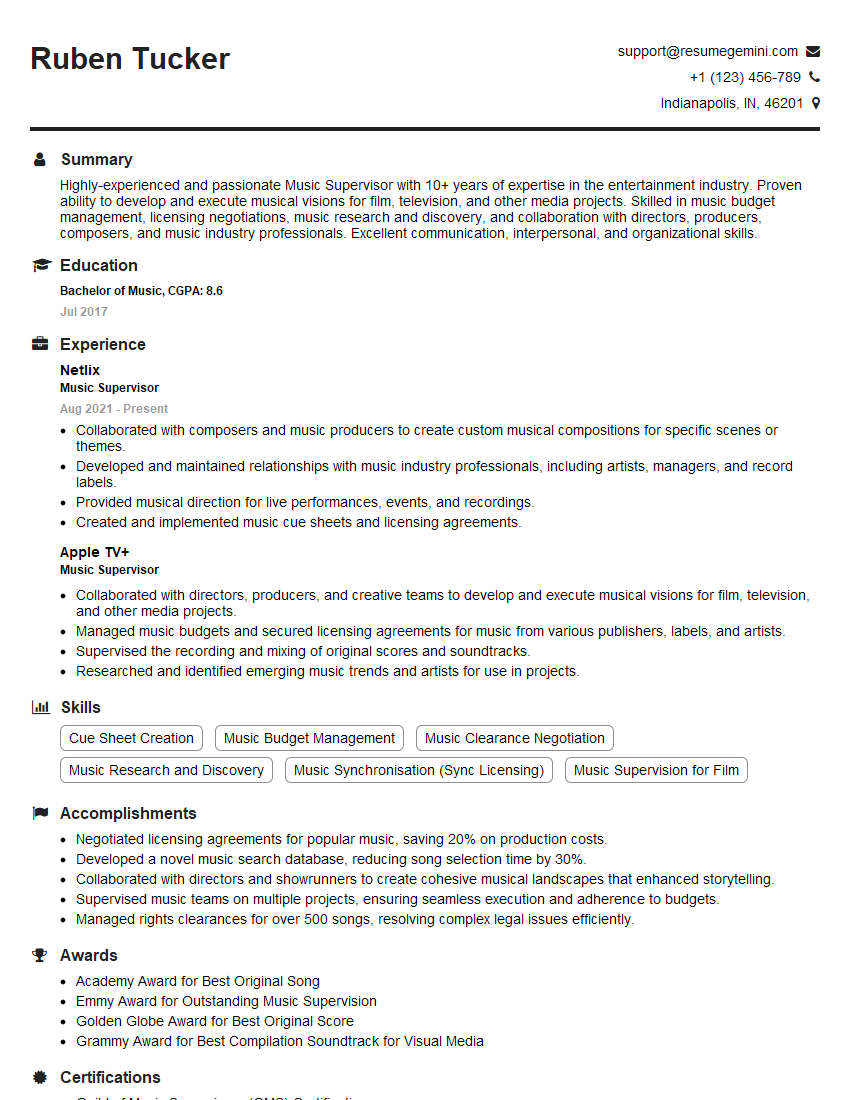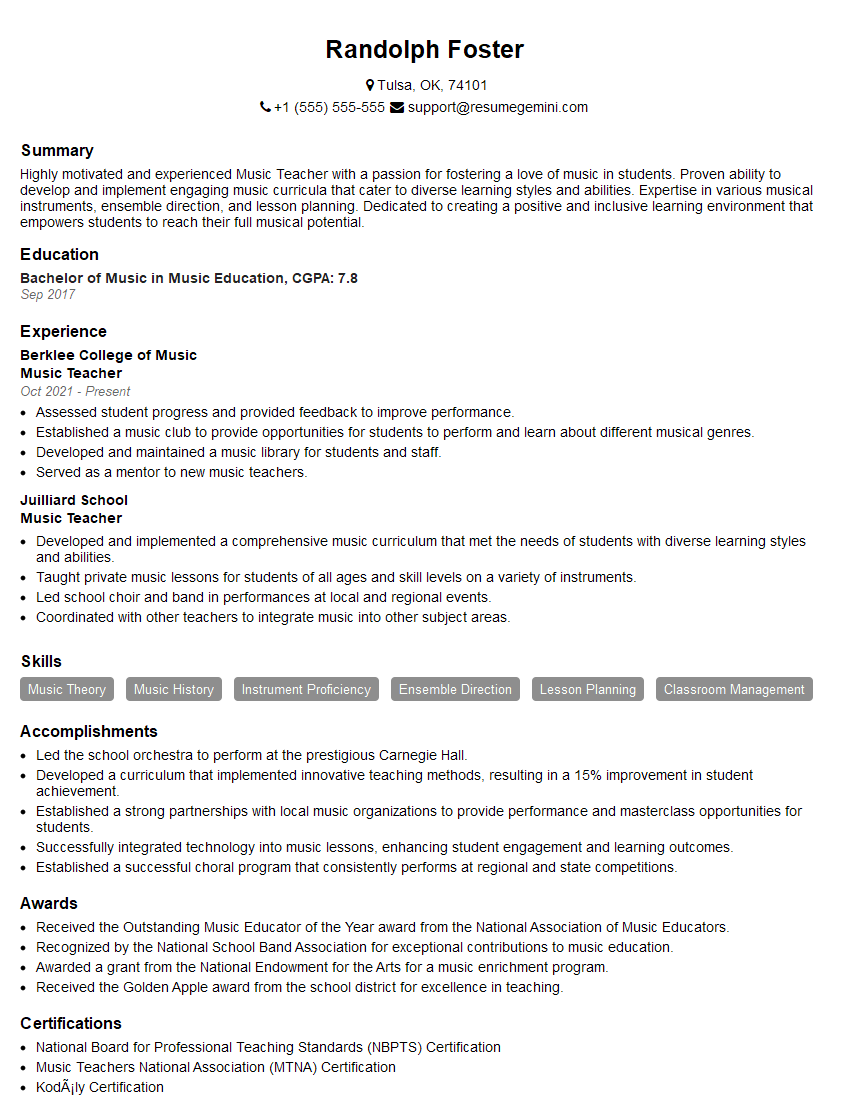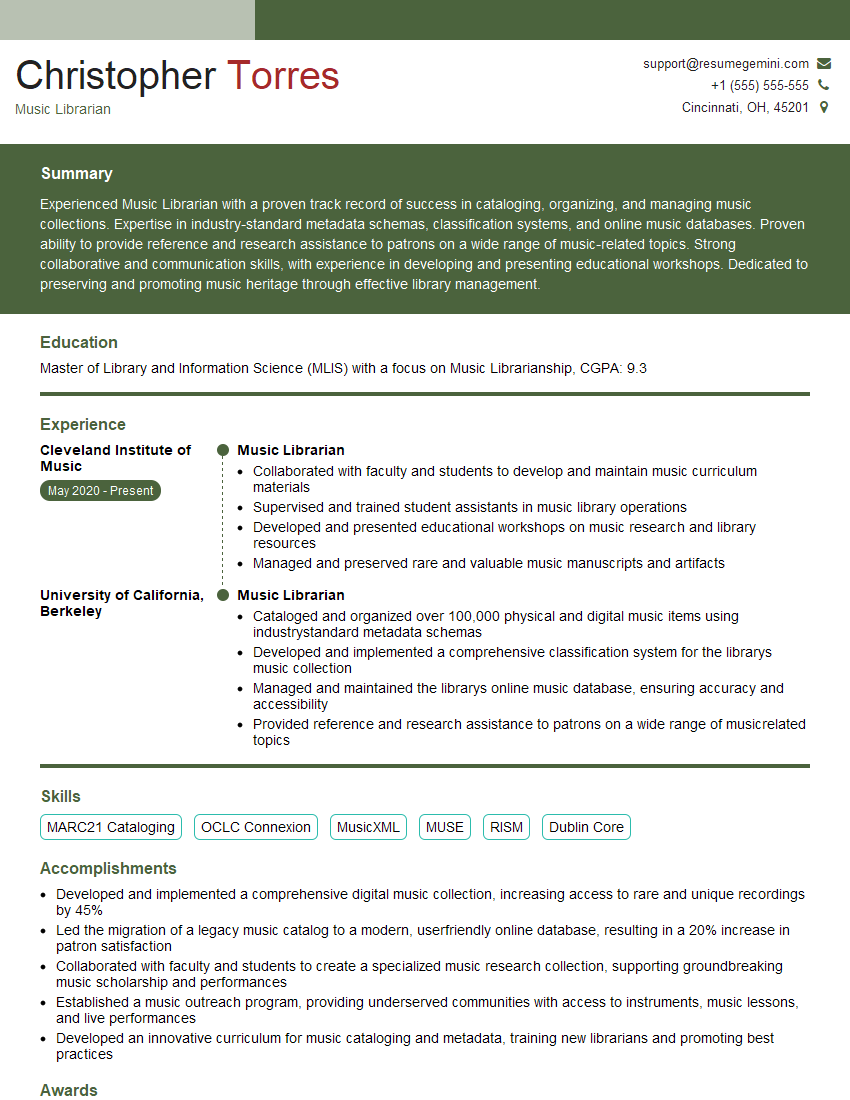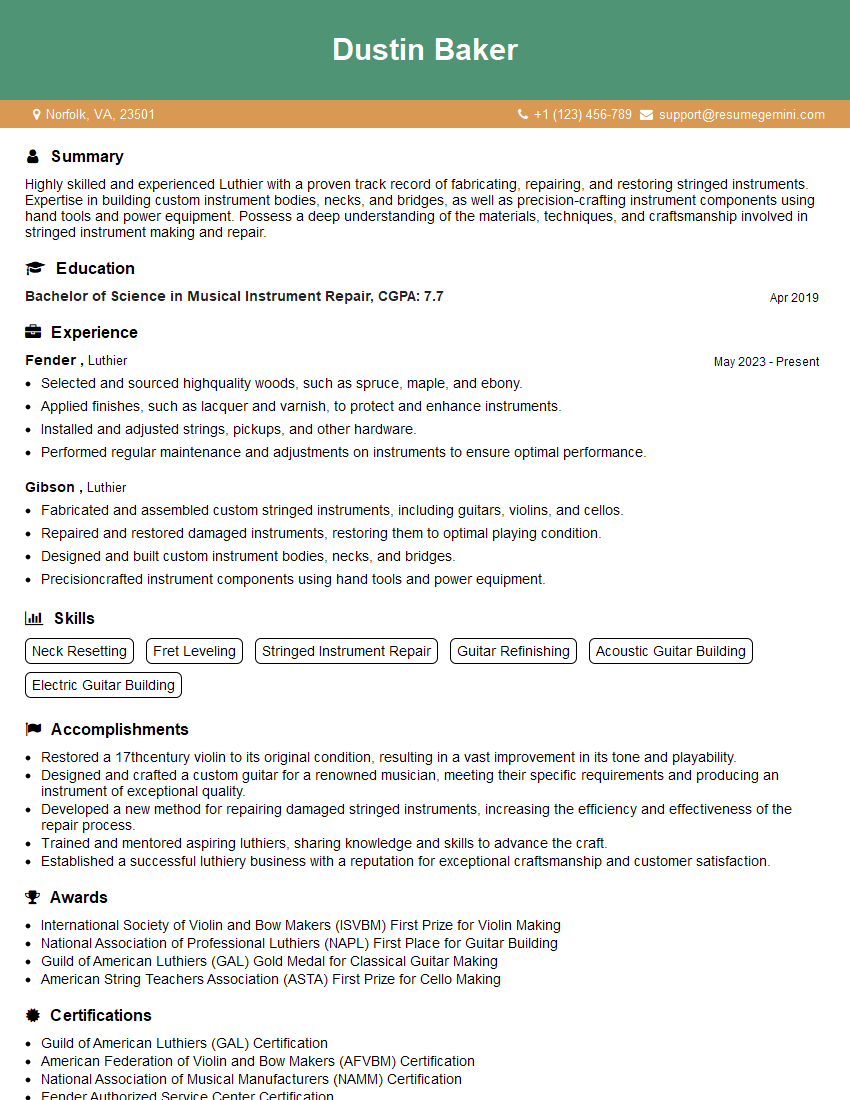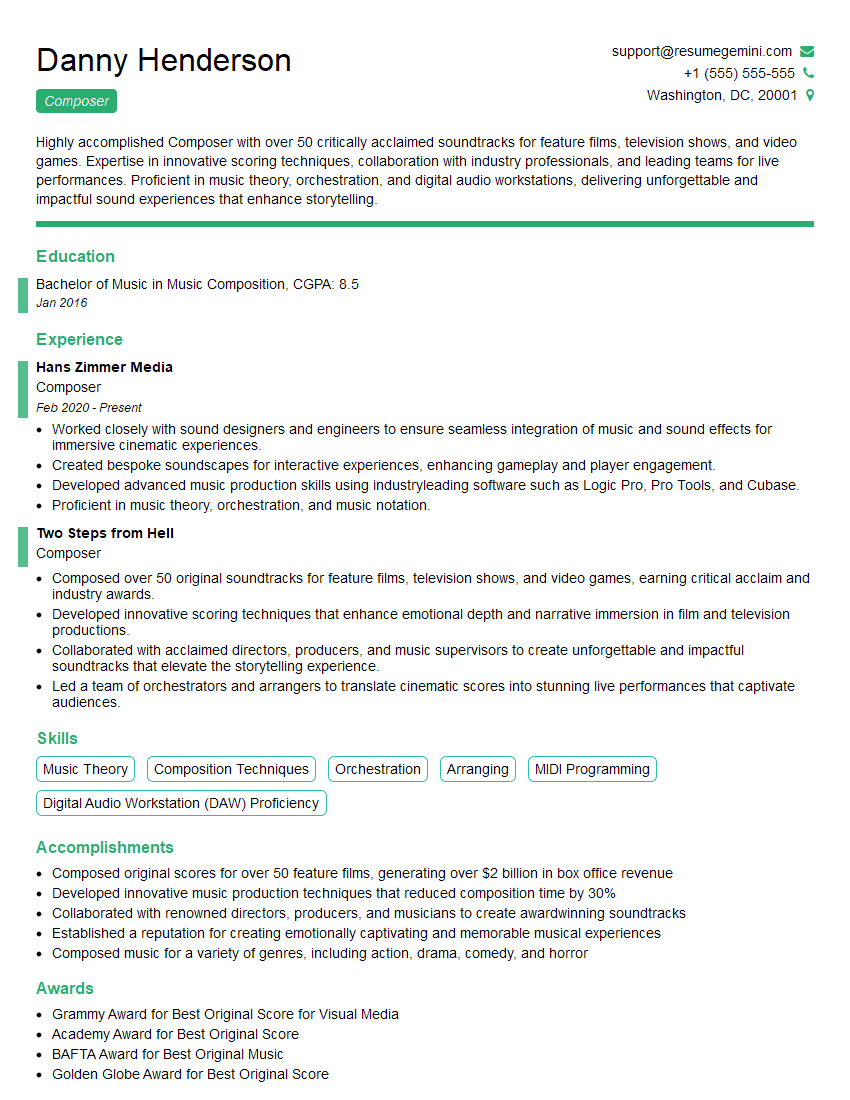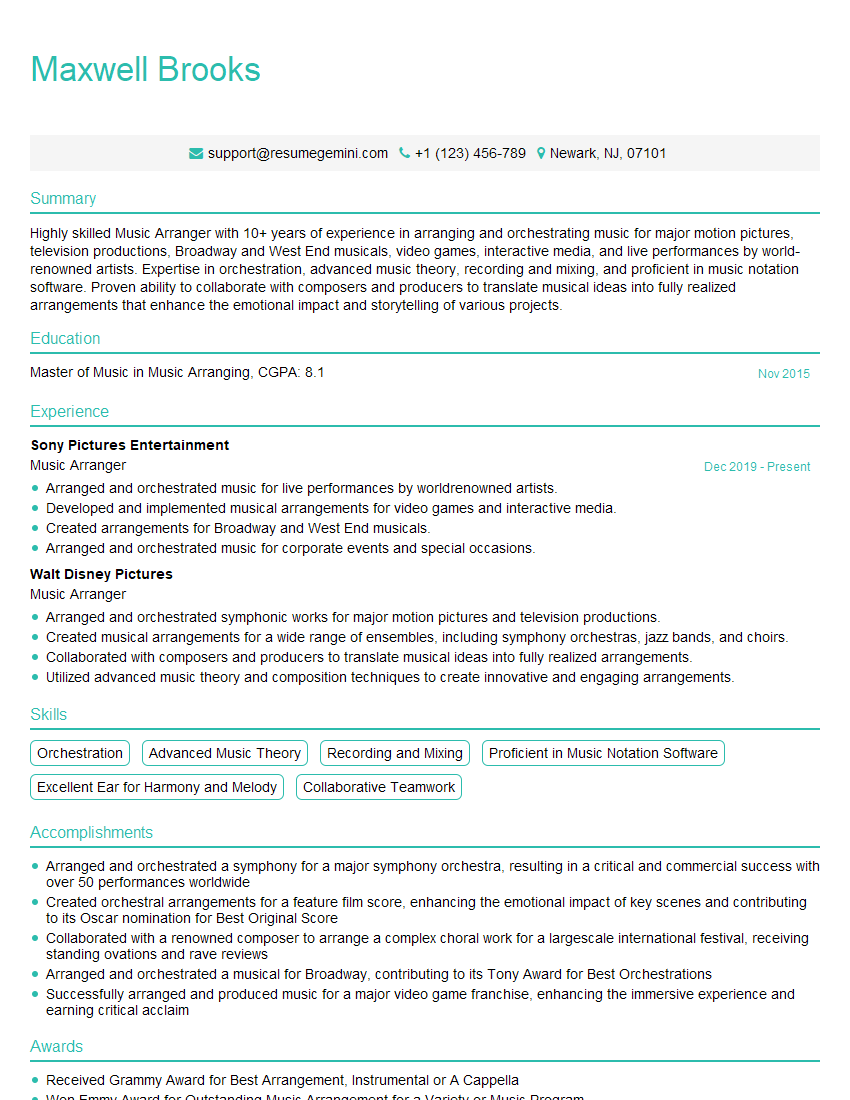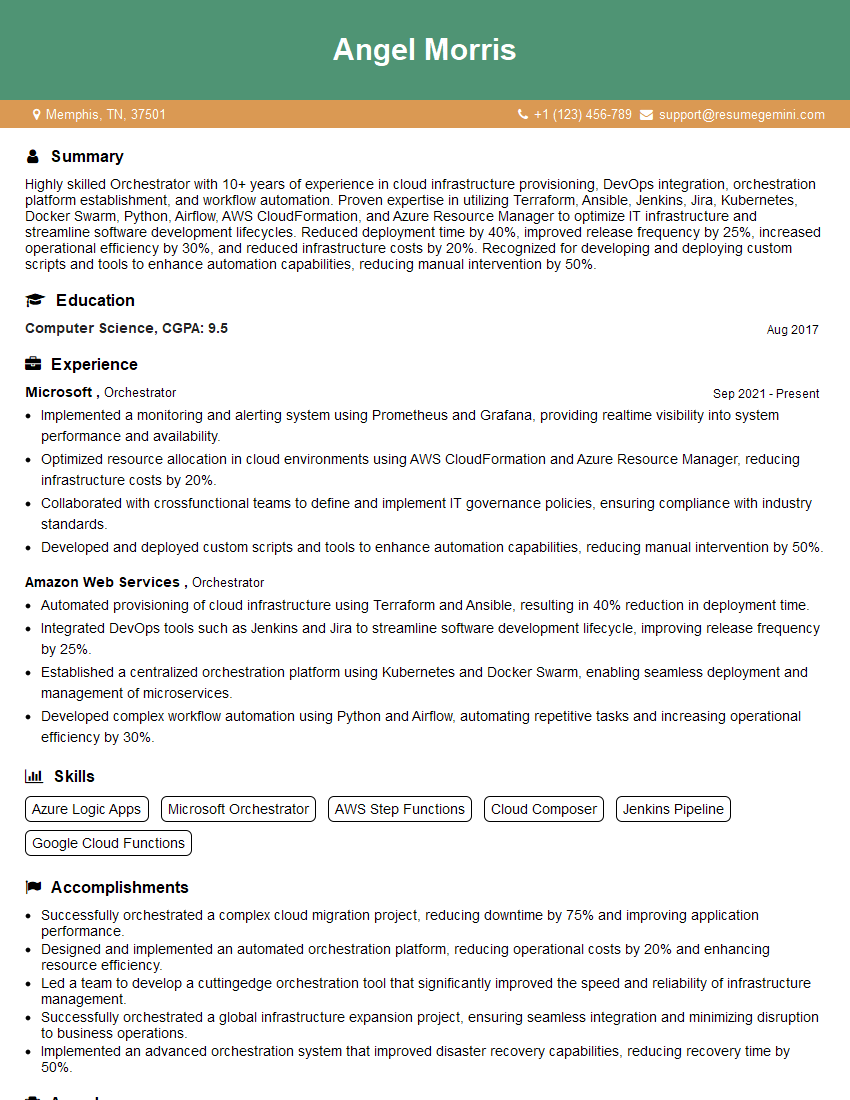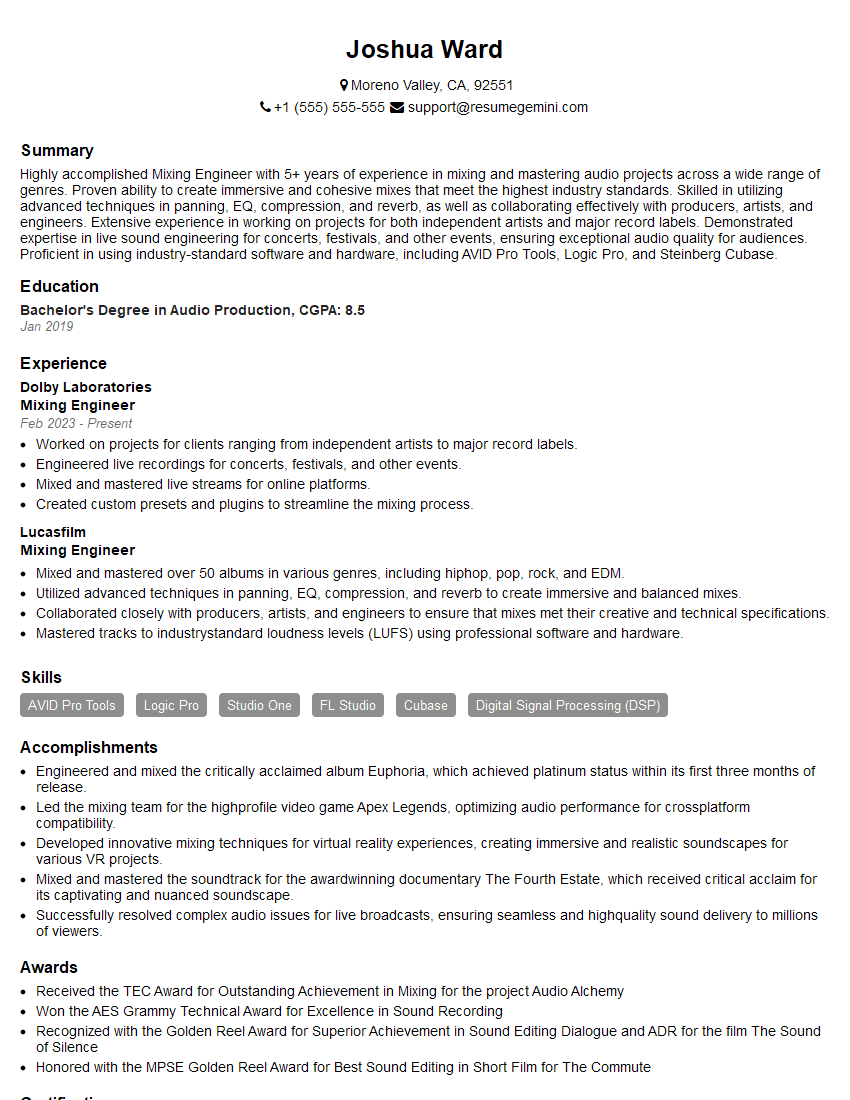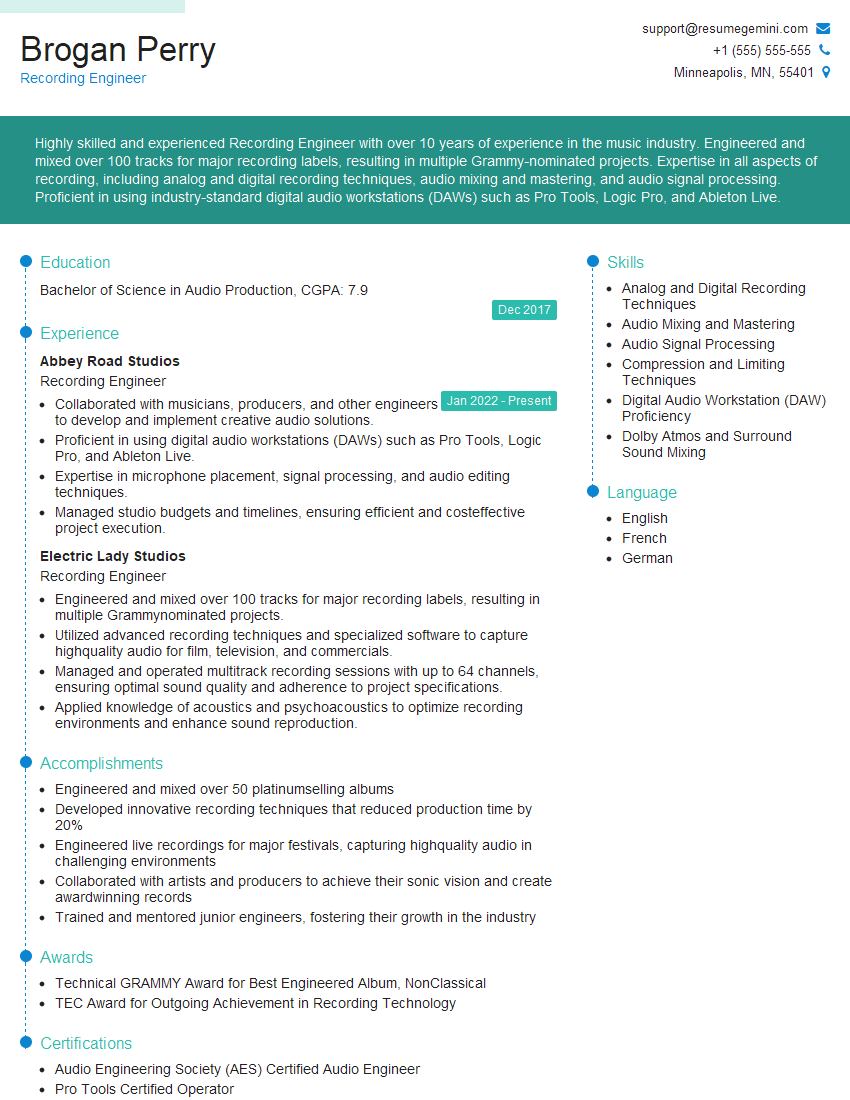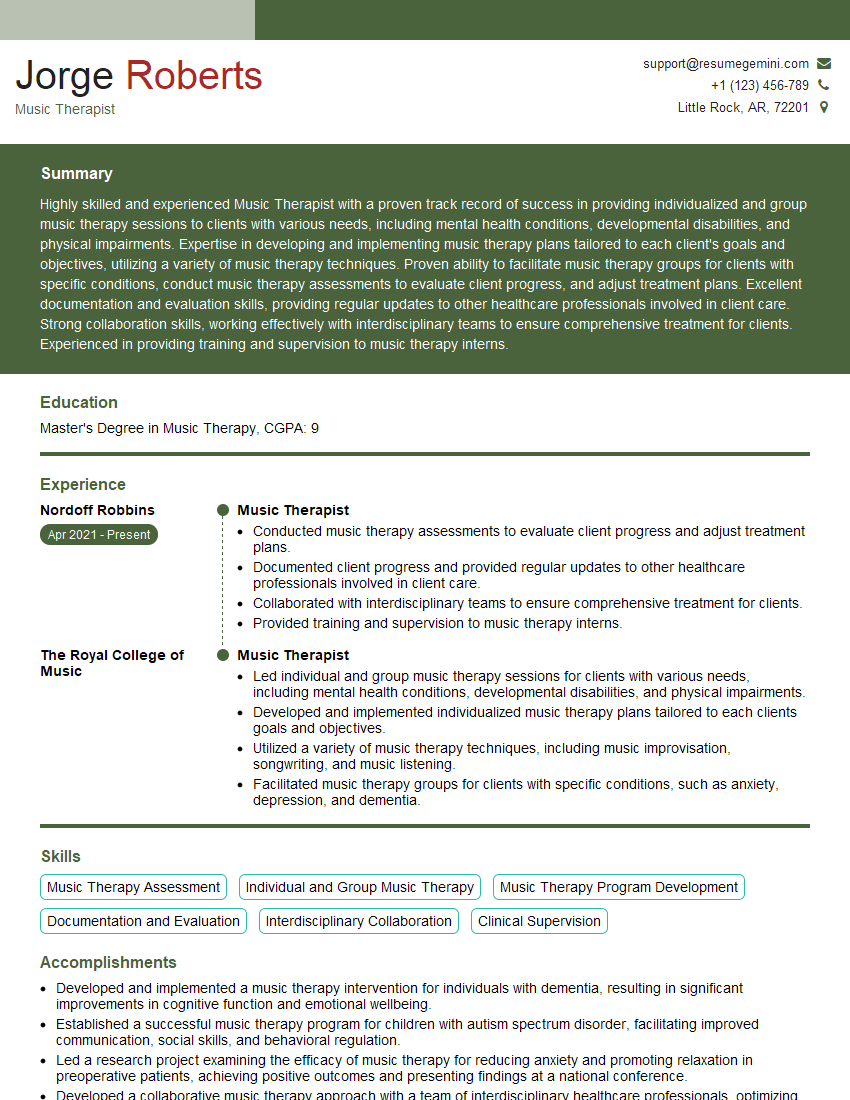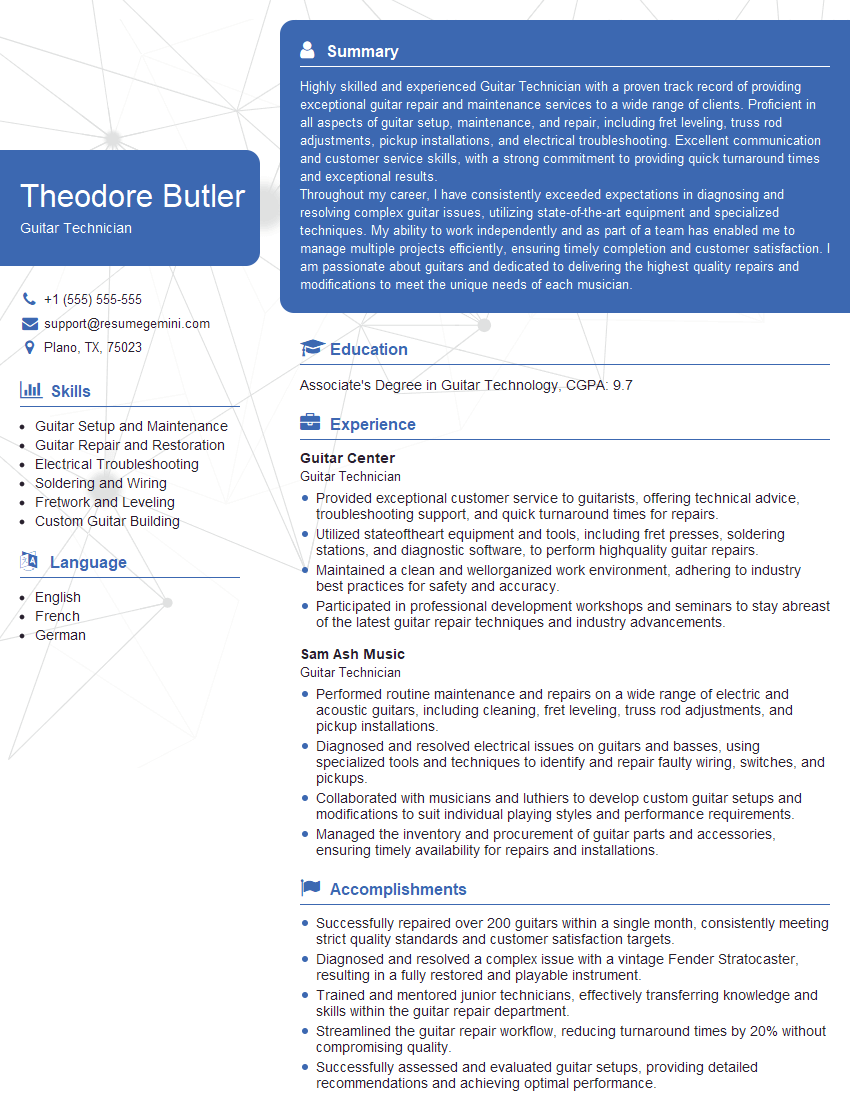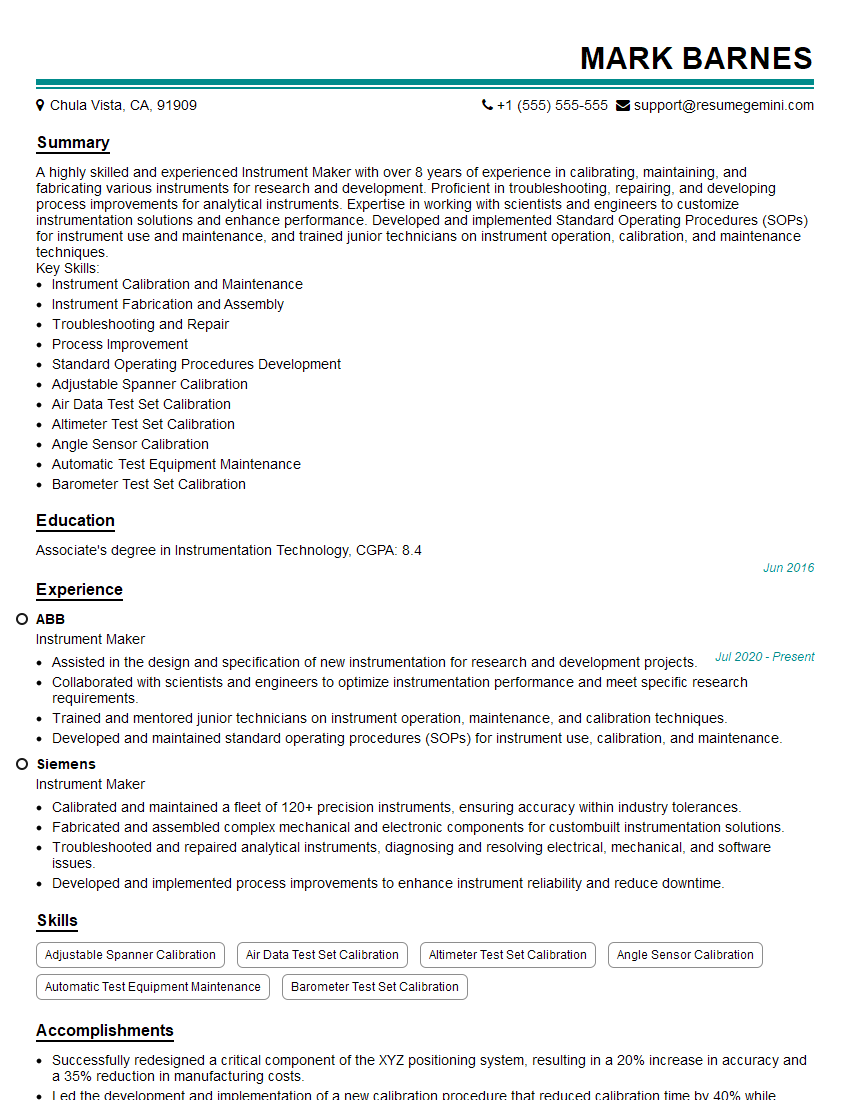Are you ready to stand out in your next interview? Understanding and preparing for Open Tuning and Alternate Tunings interview questions is a game-changer. In this blog, we’ve compiled key questions and expert advice to help you showcase your skills with confidence and precision. Let’s get started on your journey to acing the interview.
Questions Asked in Open Tuning and Alternate Tunings Interview
Q 1. Explain the advantages and disadvantages of using open tunings.
Open tunings, where one or more strings are tuned to an open chord, offer significant advantages and disadvantages for musicians. The primary advantage is the ease of playing chords. Many open chords become instantly playable with just open strings, simplifying complex fingerings and allowing for fast playing. This is especially beneficial for slide guitarists and those playing in styles like blues and folk where open voicings are prevalent.
However, open tunings also present limitations. The inherent tonal character changes, and you lose the familiar feel of standard tuning. Transposing music can be challenging, and the range of the instrument is often altered, sometimes significantly restricting the musical possibilities available. Furthermore, open tunings might not always lend themselves to all genres of music or musical approaches. The trade-off is between ease of playing certain patterns and the flexibility of standard tuning.
Q 2. Describe three common open tunings and their typical uses.
Let’s explore three popular open tunings:
- Open G (DADGBD): This is perhaps the most famous open tuning. The open strings form a G major chord. It’s widely used in blues, folk, and rock, especially for slide guitar. Many classic blues licks and riffs are inherently suited to this tuning. Think of the iconic sounds of artists like Duane Allman.
- Open D (DADF#AD): This tuning produces a D major chord when the strings are played open. It provides a bright and resonant sound, popular for folk, bluegrass, and country music. It offers easy access to D, A, and G major chords making it ideal for various styles.
- Open E (eBGDAE): A slightly altered version of standard tuning, this creates an E major chord when the strings are open. It’s well-suited for fingerstyle guitar and creating bright, jangly sounds. It’s common in contemporary and folk music.
Q 3. How does changing tuning affect the timbre and resonance of an instrument?
Altering the tuning significantly impacts both the timbre and resonance of an instrument. The tension on the strings changes directly affecting their vibrational frequency, which in turn affects the instrument’s tonal quality. A lower tuning generally produces a fuller, warmer, and sometimes more resonant sound with a stronger fundamental frequency. However, it can also cause a loss of high-frequency clarity. Higher tunings, conversely, can sound brighter, more “twangy,” and potentially less resonant.
The resonance of the instrument also shifts. Different tunings affect the instrument’s natural harmonic series and thus change which overtones are emphasized and how they interact. This is often why a particular tuning might seem to better suit a specific style of music—the resonances it creates intrinsically fit the genre’s aesthetic.
Q 4. What are some considerations when choosing an alternate tuning for a specific piece of music?
Choosing an alternate tuning for a specific piece requires careful consideration. First, analyze the music’s key and chords to determine if any open tuning would naturally complement the harmonic structure. For example, a song heavily reliant on G major chords might be well-suited for open G.
Second, consider the range of the piece. Does the alternate tuning comfortably accommodate the melody and the highest and lowest notes? The melodic range must remain playable within the tuning’s limitations. Third, think about the overall feel of the music. Does the character of the intended alternate tuning work with the desired emotional impact of the song? Does a warmer, fuller sound or brighter tone match your intentions?
Finally, practical considerations come into play: Is the tuning comfortable to play and suitable for your technique? Some tunings require substantial adaptation of fingerings and techniques.
Q 5. Explain how open tunings can simplify chord voicings and playing techniques.
Open tunings drastically simplify chord voicings. Many open chords are literally already in place when the tuning is established. This means less effort is required to play complex chord progressions, leading to increased speed and fluency. For instance, in open G, a G major, C major, and D major chords are all incredibly easy to play.
Playing techniques also benefit. Slide guitar playing is significantly enhanced by open tunings. Smooth, effortless slides across multiple strings are facilitated because the notes are already conveniently placed. This also affects strumming patterns, allowing for creative rhythmic variation that leverages the inherent open chord structure.
Q 6. How do you approach transposing a piece written in standard tuning to an alternate tuning?
Transposing from standard tuning to an alternate tuning requires a methodical approach. The most straightforward method involves using music notation software or a dedicated transposition tool. These programs allow you to input the standard tuning piece and then specify the desired alternate tuning. The software recalculates the notes accordingly.
Alternatively, a manual transposition requires careful analysis of the melody and chords. Each note needs to be adjusted relative to the new tuning. This is a laborious and error-prone process best undertaken by experienced musicians with a solid grasp of music theory. A deeper understanding of intervals is vital to ensure accuracy.
Q 7. Discuss the challenges of using alternate tunings in ensemble settings.
Using alternate tunings in ensemble settings presents unique challenges. The most significant issue is the need for coordination among all musicians. Each musician needs to be comfortable with the specific alternate tuning, and all instruments must be tuned consistently. Otherwise, the ensemble will sound dissonant or out of tune.
Moreover, many common chords and progressions will sound different. Careful arrangement and rehearsal are needed to ensure the music still sounds coherent and harmonious within the context of the altered tuning. The process of harmonization and adapting arrangements to the new sonic landscape is complex and often requires significant creative adjustments.
Q 8. How does using alternate tunings impact intonation and fretting?
Alternate tunings significantly alter the intonation and fretting experience compared to standard tuning (usually EADGBe). Intonation, the accuracy of pitches, is affected because the intervals between strings are changed. What sounds in tune in standard tuning might be slightly sharp or flat in an alternate tuning. Fretting is also altered; familiar chord shapes will produce different notes, and fingerings for melodies will need adjustment. Think of it like changing the keys on a piano – the same finger positions play different notes.
For example, consider open G tuning (DGDGBD). The open strings create a G major chord. A chord shape that might produce a C major chord in standard tuning will produce a different chord entirely in open G. You’ll need to learn new fingerings and adapt your sense of pitch to play comfortably.
Q 9. What are some common alternate tunings used in different genres of music (e.g., blues, folk, jazz)?
Different genres leverage alternate tunings to achieve specific sonic characteristics:
- Blues: Open G tuning (DGDGBD) is extremely popular, offering a droning, resonant sound ideal for slide guitar and creating a natural G major harmonic foundation. Open D (DADF#AD) is another favorite, offering similar characteristics but in D major.
- Folk: Open tunings like Open D and Open G are common here as well, providing easy access to drone-like sounds and open chords. Drop D tuning (DADGBE), where only the low E string is dropped to D, is also used for heavier folk styles, allowing for a powerful low end.
- Jazz: While less common than in folk and blues, alternate tunings can find a niche in jazz guitar. Experimentation with tunings that emphasize certain intervals or create unusual voicings is possible, although standard tuning remains the dominant choice.
Beyond these genres, many other alternate tunings exist, each with its own unique tonal color and playing characteristics. The choice often depends on the specific song or the desired mood.
Q 10. Describe how capo placement affects open tunings.
A capo fundamentally changes the effective tuning of your instrument. When you place a capo at the xth fret, you’re essentially raising the pitch of *all* strings by the interval of that fret. This drastically alters how open tunings function. The open strings will now play the notes corresponding to the fretted position of the capo.
For example, if you use open G tuning (DGDGBD) and place a capo on the second fret, your open strings will now sound as if you’re playing an A major chord (A-C#-E-A-C#-E) It’s not just an A major; it’s actually all the pitches of open G raised by a whole step. Each open string will now correspond to a different note higher in pitch than its corresponding string in the original tuning. This opens up possibilities for creating different open chord voicings without changing the actual tuning of the instrument.
Q 11. How can you calculate the intervals between strings in an alternate tuning?
Calculating intervals in alternate tunings involves comparing the frequency of each string to the others. You can do this using a couple of methods:
- Using a reference pitch: Choose one string as your reference (often the lowest). Determine its frequency using a tuner. Then, tune the other strings relative to this reference, recording the frequency of each. The interval between two strings is determined by the ratio of their frequencies. A ratio of 2:1 represents an octave, 3:2 a perfect fifth, and so on.
- Using interval notation: Write out the tuning (e.g.,
DADGBEfor Drop D). Then, using standard musical intervals (whole step, half step, etc.), determine the interval between each adjacent pair of strings. For Drop D, the interval between D and A is a perfect fifth, A to D is a perfect fourth, and so on.
Tuners designed for guitar can greatly assist in determining the frequencies, but understanding intervals is crucial for comprehension and manipulation of alternate tunings.
Q 12. Explain the concept of relative tuning and its application in alternate tunings.
Relative tuning refers to defining a tuning based on the intervals between strings, not necessarily the absolute pitch of any one string. This means you can transpose the entire tuning up or down without changing the relationships between the notes. It’s like playing a song in a different key while maintaining the chord progressions and melodic intervals.
In alternate tunings, this is incredibly useful. For example, you could take the intervals of Open G tuning (DGDGBD) and transpose them up a perfect fifth, resulting in a completely different tuning with a distinctly different sound. The *relationship* between the notes would remain the same, allowing you to adapt familiar fingerings and techniques.
Q 13. How does alternate tuning affect the tension on the strings?
Alternate tunings directly affect string tension. Lowering the pitch of one or more strings reduces tension, while raising the pitch increases it. The impact varies depending on how significantly the tuning is altered. A small change, such as Drop D, involves a relatively minor tension alteration. However, drastic changes, such as moving from standard tuning to something like Open G (especially on heavier gauge strings), can result in noticeable differences.
This change in tension must be considered for the instrument’s structure and string health. Excessively low tension can affect the instrument’s tone and playability, whereas excessive tension can damage the neck or cause premature string breakage. Experimenting requires caution, particularly when tuning down significantly.
Q 14. What are the potential risks of using excessive string tension in alternate tunings?
Excessive string tension in alternate tunings poses several risks:
- Neck damage: High tension can warp or even break the guitar neck. This is a costly repair.
- Bridge problems: Similar to neck damage, excessive tension can put strain on the bridge, potentially leading to cracks or detachment.
- String breakage: Higher tension makes strings more susceptible to breakage, especially if they are already old or of lighter gauge.
- Buzzing or fretting issues: Uneven tension might cause the strings to buzz or fret out.
- Discomfort and difficulty playing: Higher tension requires more effort to fret the strings, leading to fatigue and potential hand injuries.
It’s essential to understand the limitations of your instrument and strings. Consult a luthier or experienced guitarist before experimenting with tunings that involve significant tension changes. Using heavier gauge strings can help compensate for lower tuning to prevent excessive slack, but too high of tension can cause the problems mentioned above.
Q 15. Describe how you would troubleshoot intonation problems caused by alternate tuning.
Intonation problems in alternate tunings often stem from the increased string tension or relaxation. Troubleshooting involves a systematic approach.
- Check Tuning Stability: Ensure your tuning pegs are secure and your strings are properly seated in the nut and bridge. Use a reliable tuner, ideally one capable of handling alternate tunings. Retune as needed, paying close attention to the relationship between strings.
- Assess String Tension: High tension tunings might cause buzzing or intonation issues near the bridge. Lower tension tunings might lead to slackness and inconsistent intonation. Consider using strings of a different gauge (discussed in the next question).
- Examine Setup: A poorly set up guitar (action too high or low, nut slots too high or tight) will exacerbate intonation issues regardless of the tuning. Professional setup is often recommended when using alternate tunings frequently.
- Intonation Adjustment: If the problem persists after checking the above, a professional guitar technician may need to adjust the intonation of your guitar. This involves adjusting the bridge saddles to compensate for the stretching of the strings under the new tension.
- Ear Training: Develop your ear to recognize intonation discrepancies. Play intervals and chords against a reference pitch or drone to fine-tune your ear for specific tunings.
For example, if you’re experiencing buzzing on the higher strings in an open G tuning, the problem might be high action. If the intonation is consistently sharp or flat across the fretboard, it likely points to a setup issue requiring professional attention.
Career Expert Tips:
- Ace those interviews! Prepare effectively by reviewing the Top 50 Most Common Interview Questions on ResumeGemini.
- Navigate your job search with confidence! Explore a wide range of Career Tips on ResumeGemini. Learn about common challenges and recommendations to overcome them.
- Craft the perfect resume! Master the Art of Resume Writing with ResumeGemini’s guide. Showcase your unique qualifications and achievements effectively.
- Don’t miss out on holiday savings! Build your dream resume with ResumeGemini’s ATS optimized templates.
Q 16. Discuss the impact of different gauge strings on alternate tunings.
String gauge significantly impacts alternate tunings. Thicker strings (higher gauge) provide more tension, which is beneficial for tunings that require it, like drop tunings. Conversely, thinner strings (lower gauge) work better in tunings that relax string tension, thus avoiding issues like buzzing or excessive string breakage.
- High Tension Tunings: Tunings with significantly raised pitches benefit from heavier gauge strings. These strings provide the required tension for clear, resonant tones and prevent the strings from being overstretched, leading to breaking and intonation issues.
- Low Tension Tunings: Open tunings and certain drop tunings may necessitate lighter gauge strings. This helps to manage the reduced tension, preventing a ‘floppy’ feel and making bending easier.
Example: Open D tuning (DADF#AD) often benefits from a slightly lighter gauge than standard tuning to manage the lower tension of the D string. In contrast, a tuning like Drop C (CGCFAd), would be better served with heavier strings because of the added tension required for the low C.
Experimenting with different gauge combinations can refine the feel and tone to suit your preferences and the demands of the chosen tuning.
Q 17. How would you adapt your playing technique for an unfamiliar open tuning?
Adapting to an unfamiliar open tuning requires a conscious shift in your approach. It’s not simply about retuning; it involves reimagining your fretboard geography and phrasing.
- Learn the New Fretboard Map: Begin by visually mapping out the open strings and the resulting chords available within the tuning. Practice finding common chords and scales in the new context. This might involve creating diagrams or chord charts.
- Focus on Open String Voicings: Many open tunings exploit the resonance of open strings. Learn to use these to your advantage, building chord progressions based on the natural intervals and resonance of the open strings.
- Embrace New Chord Shapes: You’ll discover new chord shapes and inversions are now readily accessible. Experiment and develop your own approaches to finding familiar chords in this new framework.
- Gradual Transition: Don’t jump in headfirst. Start with simple exercises and familiar songs, gradually incorporating more complex techniques as you get comfortable with the new layout. Record yourself and analyze your playing to identify areas needing improvement.
For instance, transitioning from standard tuning to open G tuning requires learning the new voicings for major and minor chords. Open G’s major chord is effortlessly played on the open strings, which is a departure from standard tuning where it requires multiple finger placements. This understanding profoundly alters the improvisational landscape and makes exploring the tuning far more rewarding.
Q 18. Explain the benefits of learning different open tunings for improvisation.
Learning various open tunings significantly enhances improvisation. The different intervals and inherent chord structures unlock new melodic and harmonic possibilities.
- Expanded Harmonic Palette: Open tunings often present immediate chord voicings that are naturally resonant and evocative. This enriches the harmonic landscape for improvisers, fostering unique chord progressions and transitions.
- New Modal Explorations: The specific intervallic structure of an open tuning can naturally lend itself to exploring specific modes or scales. This can provide a focused harmonic environment that can stimulate creativity.
- Simplified Fingerings: Many open tunings simplify the process of creating complex chord inversions, facilitating faster and more fluid transitions. This allows for a greater focus on melody and phrasing during improvisation.
- Unique Sonic Character: Each tuning possesses a unique sonic signature, impacting the feel and character of the music. This expands the potential range of your expressive capabilities as an improviser.
For example, open G tuning (DGDGBD) provides easy access to major and minor pentatonic scales that can be embellished using the resonance of the open strings. This provides a rich and distinct sonic quality compared to improvisation in standard tuning.
Q 19. What are some resources you use to explore and learn new alternate tunings?
Exploring alternate tunings requires a multi-faceted approach utilizing different resources.
- Books and Publications: Dedicated books on guitar tunings provide theoretical and practical knowledge, often including tablature and examples.
- Online Resources: Websites and online forums dedicated to guitar playing offer a wealth of information, including discussions, tutorials, and tablature for various tunings.
- Music Transcriptions: Transcribing music written or performed in alternate tunings allows for direct study of how other musicians utilize those tunings.
- Software and Apps: Guitar tuners, DAWs (Digital Audio Workstations), and notation software often have features that support alternate tunings, facilitating easier experimentation.
- Listening and Studying: Active listening to music utilizing alternate tunings, paying attention to the sonic qualities and techniques employed, is vital for understanding the potential of a specific tuning.
A combined approach, actively engaging with theoretical materials alongside practical experimentation, allows for a comprehensive understanding of alternate tunings and their applications.
Q 20. How do you approach composing or arranging music for a specific alternate tuning?
Composing or arranging for a specific alternate tuning necessitates a different compositional approach compared to standard tuning.
- Understand the Tuning’s Character: Begin by thoroughly understanding the tuning’s harmonic and melodic possibilities. Explore the intervals, available chords, and scales intrinsic to that tuning.
- Develop Chord Progressions: Create chord progressions and harmonic structures that effectively utilize the inherent resonant properties and accessible chords within the tuning.
- Compose with Open Strings: Leverage the open strings as a foundational element, building chord voicings and melodies around their resonance.
- Adapt Existing Material: Transcribe or adapt existing pieces, experimenting with how those pieces resonate in the new tuning. This can reveal interesting reinterpretations.
- Experiment with Instrumentation: Consider how other instruments might complement the chosen tuning.
For instance, composing for open G emphasizes using the open G string as a drone, creating music that builds around this foundation. You might construct melodies that naturally use the intervals inherent within the tuning, leading to a characteristic sound for that particular tuning.
Q 21. Discuss the role of alternate tunings in achieving specific sonic effects.
Alternate tunings play a crucial role in achieving specific sonic effects, significantly altering the timbre, feel, and expressive capabilities of an instrument.
- Creating Drone Effects: Certain tunings, like open tunings, allow for sustained drone notes to be created easily, providing a foundation for textures and ambient soundscapes.
- Enhancing Resonance: Open tunings maximize the resonance of open strings, creating a richer, more full-bodied sound compared to standard tuning.
- Altering Timbre: Different tunings change the tension of the strings, altering the timbre or tone colour produced. Some tunings might create a brighter, more jangly tone, whereas others might produce a darker, more mellow tone.
- Facilitating Specific Intervals: Alternate tunings can facilitate easier access to particular intervals and chord voicings that might be more challenging or awkward in standard tuning.
- Modifying Feel and Mood: The inherent character of a tuning can directly impact the mood and atmosphere of the music, creating a sense of mystery, tranquility, tension or energy.
For example, using open tunings can enhance the sense of spaciousness and resonance, especially in folk or ambient music. Drop tunings, on the other hand, frequently create a heavier, darker sonic palette suitable for rock or metal genres.
Q 22. How would you explain the concept of open tunings to a beginner musician?
Open tunings, in simple terms, are any guitar tuning that’s different from the standard tuning (E A D G B e). Instead of tuning each string to a specific pitch, you intentionally adjust the strings to create a unique sonic landscape. Think of it like changing the gears in a car – each tuning offers a different feel and playing experience. For example, in an open tuning, several strings might form a chord when played open (without fretting). This allows for easy access to certain chords and harmonic possibilities.
Imagine tuning your guitar so that when you strum all six strings open, you immediately hear a G major chord. That’s the essence of an open tuning. This simplifies playing certain styles and creates a distinctive sound. Beginner musicians can benefit greatly from learning open tunings to quickly grasp chord voicings and develop unique stylistic approaches.
Q 23. What are some software or tools that can help with working with alternate tunings?
Several software and tools aid in working with alternate tunings. Guitar Pro is a popular choice, allowing you to define custom tunings and easily transpose between them. Other digital audio workstations (DAWs) such as Ableton Live, Logic Pro X, and GarageBand also feature comprehensive tuning options. These DAWs provide the ability to adjust the pitch of individual strings or even entire tracks to match your preferred tuning. Furthermore, many tuner apps for smartphones and tablets let you easily set a custom tuning.
Beyond software, a simple physical tuner (either digital or analog) is crucial. It allows precise tuning adjustments, regardless of your chosen tuning.
Q 24. Explain the relationship between alternate tunings and different musical scales and modes.
Alternate tunings have a profound relationship with scales and modes. A specific tuning can naturally emphasize certain scales or modes by making their notes easily accessible on the fretboard. For instance, open G tuning (D G D G B D) lends itself beautifully to playing in the G major scale and its related modes like Mixolydian. The open strings themselves often form the root, fifth, and octave of the tonic chord, making chord progressions within that scale feel exceptionally intuitive.
Conversely, choosing a tuning that doesn’t align well with the song’s underlying scale can make playing difficult and the resulting music feel dissonant. Therefore, a deep understanding of music theory and the interplay between scales, modes and tunings is vital for effective composition and improvisation in alternate tunings.
Q 25. Discuss the historical context and evolution of using alternate tunings.
The use of alternate tunings has a rich history, stretching back centuries. While standard tuning became prevalent, many composers and instrumentalists throughout history experimented with different tunings to achieve particular expressive qualities. Early music often used tunings significantly different from our modern standard. The Renaissance and Baroque periods saw the use of various meantone temperaments, which are systems of tuning that differ from equal temperament.
The 20th and 21st centuries saw a resurgence in open tunings, especially in folk, blues, and experimental music genres. Artists like John Fahey, Jack Rose, and many contemporary players have championed alternate tunings, demonstrating their creative potential.
Q 26. How does the choice of alternate tuning influence the overall mood and feel of a composition?
The choice of alternate tuning profoundly influences the mood and feel of a composition. Open tunings often create a more relaxed, spacious sound due to the ease of playing open chords. Tunings that involve wider intervals between strings can create a more dramatic or dissonant feel. For instance, tunings with significantly lowered strings often lend a darker, more melancholic feel to a piece, whereas tunings with higher pitches can sound brighter and more energetic.
Think of it like choosing a specific color palette for a painting. Different tunings offer different sonic color palettes, setting the overall emotional tone.
Q 27. How would you determine the most appropriate alternate tuning for a given song’s melody and harmony?
Determining the appropriate alternate tuning for a given song begins with analyzing its melody and harmony. Identify the key and predominant chords. Then, experiment with tunings that highlight those chords. You might find that an open tuning based on the tonic chord of your song provides an easy pathway to playing the song.
Software like Guitar Pro can be invaluable in this process. You can input your song’s chords, try different tunings, and see how they affect the fretboard layout and the feel of the piece. It’s a process of experimentation and listening; you need to find the tuning that resonates best with the song’s mood and overall musical intent.
Q 28. Can you describe a situation where you used an unconventional alternate tuning to solve a musical problem?
I once worked on a piece with a melody that was unusually challenging to play in standard tuning. The melody involved frequent and awkward stretches across the fretboard. After multiple attempts at arrangement, I decided to experiment with an unconventional tuning: C G D G B D. This tuning placed many of the melody notes on open strings or easily accessible frets. The resulting arrangement was dramatically easier to play, freeing me to focus on the expressive aspects of the performance.
This demonstrates that sometimes, stepping outside of standard practices and embracing unconventional solutions can lead to significant creative breakthroughs. Finding the right tool, in this case an alternative tuning, can be the key to unlocking a piece’s full potential.
Key Topics to Learn for Open Tuning and Alternate Tunings Interview
- Understanding Open Tunings: Explore the various common open tunings (e.g., Open D, Open G, Open A) and their characteristic sounds. Consider the theoretical basis for their popularity and suitability for different musical genres.
- Alternate Tunings: Delve into the concept of alternate tunings beyond open tunings. Discuss the advantages and disadvantages of various alternate tunings, and how they affect chord voicings and melodic phrasing.
- Chord Construction and Voicings in Alternate Tunings: Learn how to build chords and understand their inversions within different tunings. Practice constructing common chord progressions in open and alternate tunings.
- Practical Applications: Discuss the use of open and alternate tunings in specific musical styles (e.g., blues, folk, rock). Analyze how these tunings contribute to the overall musical aesthetic and expression.
- Improvisation and Soloing: Explore techniques for improvising and soloing in open and alternate tunings. Consider how the altered intervals affect melodic phrasing and harmonic choices.
- Tuning Methods and Technologies: Understand different methods for achieving accurate tuning, including electronic tuners and alternative methods. Discuss the impact of intonation and tuning accuracy in open and alternate tunings.
- Problem-Solving Approaches: Prepare to discuss how you would troubleshoot tuning issues, adapt to unfamiliar tunings, and creatively solve musical challenges related to alternate tunings.
- Theoretical Frameworks: Relate the use of open and alternate tunings to relevant music theory concepts such as intervals, scales, modes, and harmony.
Next Steps
Mastering open and alternate tunings demonstrates adaptability, creativity, and a deep understanding of music theory and practice. This skill is highly valuable in various musical contexts and significantly enhances your career prospects. To increase your chances of landing your dream role, it’s crucial to have a resume that effectively communicates your skills and experience to potential employers. Building an ATS-friendly resume is essential in today’s job market. We recommend using ResumeGemini to craft a professional and impactful resume that highlights your expertise in open tuning and alternate tunings. ResumeGemini provides examples of resumes tailored to this specific skill set, assisting you in creating a winning application.
Explore more articles
Users Rating of Our Blogs
Share Your Experience
We value your feedback! Please rate our content and share your thoughts (optional).
What Readers Say About Our Blog
Hello,
We found issues with your domain’s email setup that may be sending your messages to spam or blocking them completely. InboxShield Mini shows you how to fix it in minutes — no tech skills required.
Scan your domain now for details: https://inboxshield-mini.com/
— Adam @ InboxShield Mini
Reply STOP to unsubscribe
Hi, are you owner of interviewgemini.com? What if I told you I could help you find extra time in your schedule, reconnect with leads you didn’t even realize you missed, and bring in more “I want to work with you” conversations, without increasing your ad spend or hiring a full-time employee?
All with a flexible, budget-friendly service that could easily pay for itself. Sounds good?
Would it be nice to jump on a quick 10-minute call so I can show you exactly how we make this work?
Best,
Hapei
Marketing Director
Hey, I know you’re the owner of interviewgemini.com. I’ll be quick.
Fundraising for your business is tough and time-consuming. We make it easier by guaranteeing two private investor meetings each month, for six months. No demos, no pitch events – just direct introductions to active investors matched to your startup.
If youR17;re raising, this could help you build real momentum. Want me to send more info?
Hi, I represent an SEO company that specialises in getting you AI citations and higher rankings on Google. I’d like to offer you a 100% free SEO audit for your website. Would you be interested?
Hi, I represent an SEO company that specialises in getting you AI citations and higher rankings on Google. I’d like to offer you a 100% free SEO audit for your website. Would you be interested?
good
